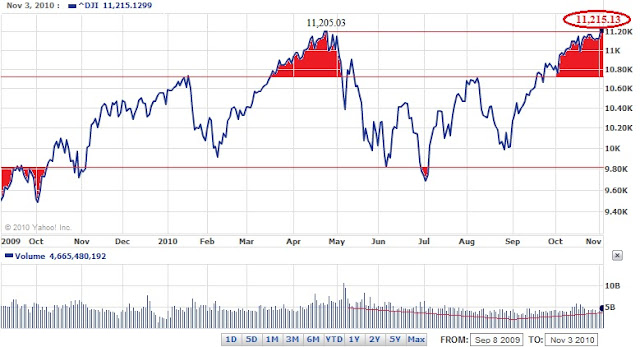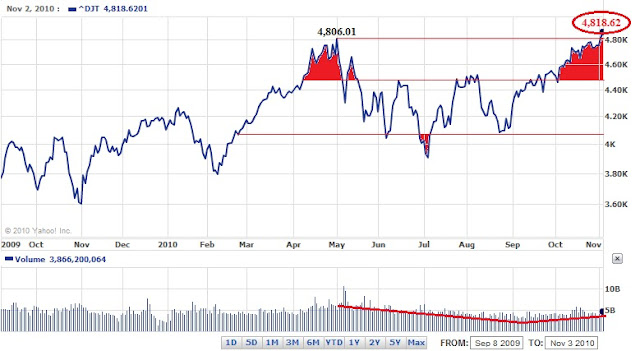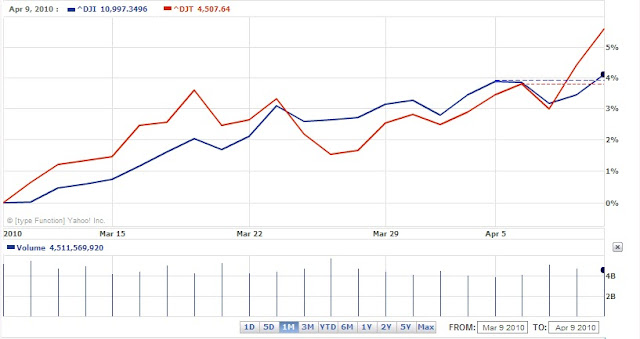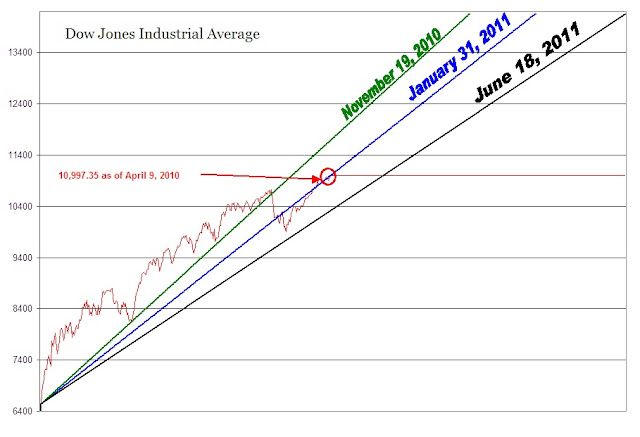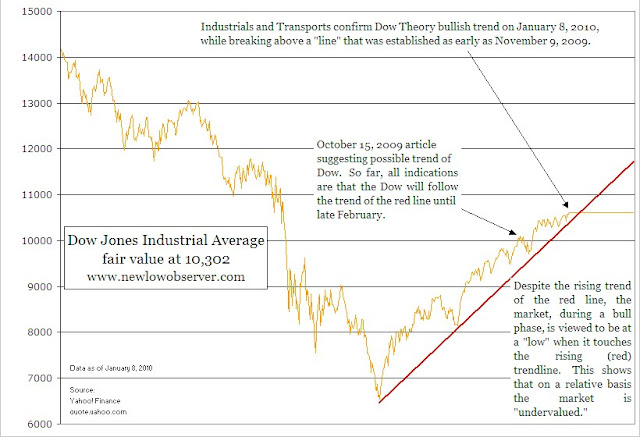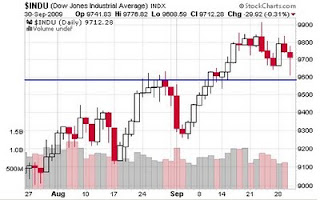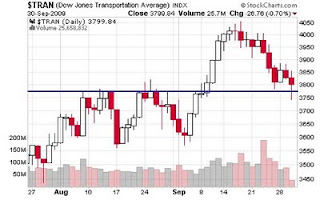Dow Theory is only a theory. Therefore, it is necessary to take all indications with a tremendous grain of salt. However, it has been our endeavor to determine the qualitative nature of the work as presented by anyone who writes on the topic. One individual that we’ve found of interest is Manuel Blay on SeekingAlpha.com. Mr. Blay provides commentary on elements of Dow Theory and in this piece we’d like to examine the performance of the market calls associated with the concept of Dow Theory.
How do we arrive at performance data? We take the date that a primary trend bull/bear market is indicated and looked for the date for when the indicated stock, ETF or index next received a change to the primary trend bear/bull market indication. This seems the best way to gauge the concept of performance even though we understand that there are nuances to actual start and end dates. The very end of this article has the internet links and dates associated with the collection of performance data.
Anyone interested in Dow Theory should make it their goal to identify, whenever possible, what the primary trend of the stock market is based on the movements of the Dow Jones Industrial Average and Dow Jones Transportation Average. The goal of identifying the primary trend is to maximize profits while avoiding as much loss as possible. In the case of Mr. Blay, he has applied Dow Theory to ETFs and individual stocks as well as the usual stock market indexes.
For each bullet point below, we only took the date of the call for a “primary bear market” or “primary bull market” and measured the respective stock, ETF, or index for percentage change. If it was a bear market and the percentage change was negative from the primary bear market signal to the subsequent primary bull market signal then, on the whole, we’d consider that Dow Theory met expectations as a tool for profitable investing (green font).
Alternatively, if it was a bear market and the percentage change was positive from the primary bear market signal to the subsequent primary bull market signal then, on the whole, we’d consider that Dow Theory did not meet expectations (red font).
There may be errors in our ability to identify any subsequent bull or bear market article, however, below is our best effort to identify any change to the primary trend based on the work of Manuel Blay (We’d give a margin of error +/-1% to any estimate.):
-
Bear Market: –31.54% for GDX
-
Bear Market: –26.08% for SIL
-
Bull Market: –24.91% for GDX
-
Bull Market: –26.95% for SIL
-
Bull Market: –5.24% for HAO
-
Bear Market: +7.46% for DJT
-
Bear Market : +6.21% for DIA
-
Bear Market: +7.00 for SPY
-
Bull Market: -9% for GDX
-
Bull Market: –23% for SIL
-
Bull Market: –11.30% for GLD
-
Bull Market: –16.01% for SLV
-
Bear Market: +8% for DIA
-
Bear Market: +7% for SPY
-
Bear Market: +8% for DJT
-
Bear Market: +4% for HAO
-
Bull Market: +2% for DIA
-
Bull Market: –9% for GLD
-
Bull Market: –11% for SLV
-
Bear Market: +17% for GLD
-
Bear Market:+10% for SLV
-
Bear Market: +2.60% for DIA
-
Bear Market: +52% for GDX
-
Bear Market: +58% for SIL
-
Bull Market: –4.39% for DIA
It could be argued that the date that the primary trend changed was not the same as the publish date of the article. However, as a person interested in Dow Theory, you probably could only act on what is published and not the literal date that the market made a presumed bull or bear market primary trend change.
Among all 25 instances of a bull or bear market primary trend indication, only three (#1, #2 and #17) had performance that was expected of Dow Theory. All of which leads to the obvious question, why would Dow Theory provide such disastrous results when the whole point of Dow Theory is to take advantage of primary trends in the stock market?
Primary Trend Bull Markets
Our view on the lack of performance at the conclusion of a primary trend bull market is best stated by Charles H. Dow himself when he said:
"We have frequently demonstrated that the stock market, while full of short fluctuations [also known as secondary reactions], has a continuing main movement, which often runs in one direction for three or four years at a time. (source: Dow, Charles H. Review and Outlook. Wall Street Journal. September 13, 1900)."
We believe that the primary trend indications provided by Mr. Blay are not long enough to be meaningful and advantageous. The lone exception, in terms of time, HAO from September 13, 2013 to August 21, 2015, still garnered a performance that was counter to the goal of Dow Theory (primary trend bull market but lost –5.24%).
When a signal is given in a period that is less than a year for a primary trend bull market, we would reassess the current and previous interpretation to determine where we went wrong, because clearly, calling a full cycle of a (bull-bear-bull) primary trend WITH negative returns does not augur well for Dow Theory analysis. If the (primary trend bull market) is less than a year then something is wrong.
Primary Trend Bear Markets
Alternatively, it is known that primary trend bear market last ⅓ to ½ as long as the preceding bull market. Therefore, we cannot hold primary trend bear market signals to the same time criteria as primary trend bull markets. A collapse in the market (a la 1987) resulted in a bear market to bull market signal in less than 5 months.
Do you short bear market for additional gains? If the performance data for Mr. Blay is any indication, we wouldn’t recommend short selling primary trend bear markets. Only in the very first case (#1) were we able to see a bear market with declines by the end of the bear market period.
Dow Theory in Three Steps
What does a Dow Theory primary trend bull or bear market look like, in theory?

Again, this is a theoretical look at the way primary trends should transpire. Anyone who plays the “Dow Theory” game will need to accept some missed opportunities like the very top and very bottom of a market move. Notice that each primary trend indication occurs after a peak or trough. This is the point at which a low or peak has been reached, is then retested but not violated, then continues in opposition to the previous primary trend.
What does the above primary trend chart mean? It means that as an investor who attempts to apply Dow Theory, you should see some investment gain no matter which market you’re in. While the amount of the gains will vary, the net result should be positive percentage change in a primary trend bull market and negative percentage change (for short sellers) in a primary trend bear market.
Mr. Blay’s performance of 12% correlation with the primary trend suggests that either Dow Theory doesn’t work, that the analysis was incorrect or that Dow Theory AND the analysis don’t work. We’d argue in defense of Dow Theory being reasonably accurate and the interpretation being incorrect in this instance. An investor cannot be faced with 88% of calls not correlating with the primary trend.
A Line or Trading Range
Missing from the above chart is the period of time that the market wallows in a trading range. The concept of trading range or “line” does get addressed by Charles Dow and is best described by William Peter Hamilton, fourth editor of the Wall Street Journal, as indicated in the following commentary:
“Such a narrow fluctuation, to the experienced student of the averages, may be as significant as a sharp movement in either direction.” Rhea, Robert. The Dow Theory. Barron’s (1932). page 82.
Hamilton suggests that a trading range is equal to or greater than a parabolic move up or market crash. The current market environment has provided us with what we believe is a trading range which began in February 2014.

With a range of 6.70% between the middle of the line and the top/bottom, any breakout above or below the range should result in exceptional change in the index. However, these processes are a function of market sentiment which generally plays out over time. A line can last for quite some time and Dow Theory has been clear in saying that the previous trend is still in effect until the line is broken. (the Dow Jones Industrial Average isn’t the only element necessary to achieve a Dow Theory primary trend change.)
Conclusion
It is very clear that Mr. Blay is dedicated to the work he does in Dow Theory. He writes on the topic almost every other day. However, Dow Theory moves at a glacial pace and requires stepping away from the topic. None of the great Dow Theorists (Russell, Schaefer, Omerod, Fritz, Shumate, Rhea, Hamilton, Nelson, and Charles H. Dow) carried an account of market action with primary trend changes with the frequency that has been displayed by Mr. Blay.
There is no way that a person could be applying Dow Theory and come away with, at least on paper, results that are the exact opposite of each call in the change of the primary trend. As shown in the cycle chart above, there is a theoretical sweet spot where a gain will be made if you go long in a primary trend bull market and go short in a primary trend bear market. Yet, in neither case, except in the three out of 25 instances cited above, was it possible to demonstrate gains.
For anyone interested in Dow Theory, when you see primary trend changes at such a high frequency you have to be very critical of the work. When you see the above performance that is attributed to Dow Theory analysis, then you should know that you’re not witness to Dow Theory at all.
References:
-
-
-
-
-
-
-
-
-
-
-
-
-
-
-
June 27, 2016 BEAR market for DIA. Performance since BEAR market call for DIA is
+6.89% as of July 13, 2016.









